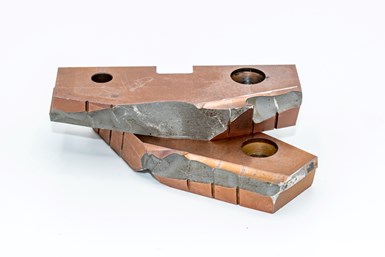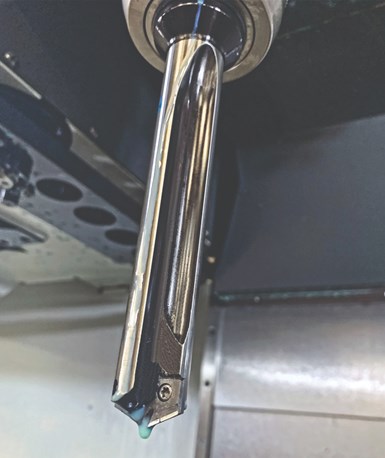Tips to Make CNC Machining Tool Failure Predictable
Accurate prediction of tool life is key to establishing a controlled, repeatable and reliable CNC machining process.

Recognizing one’s machining limitations, in addition to simply being prepared, are key in predictive tool failure. Being more knowledgeable about an application, whether that is through data collection or proper training, enables shops to better establish the desired repeatability. (Photo credit: Allied Machine and Engineering)
Tool life is often a top priority when working in a high-production environment. To some extent, it is more important to use a tool that fails consistently and in the same manner than it is to have one that cuts faster. But, how can a shop achieve this? How can a shop proactively plan for predictable tool failure?
According to Allied Machine and Engineering, manufacturer of holemaking and finishing tooling systems, outside factors such as coolant, material hardness and machine maintenance can affect tool failure consistency. While it is unrealistic to hit 100% repeatability, it is key to keep as many factors as possible the same from job to job and part to part. Establishing repeatability makes it easier to prevent catastrophic failure that will damage the workpiece and tooling, which becomes much more expensive than just taking the tool out early even if that is before it is completely worn. Therefore, cost savings is one of the biggest benefits of consistent tool life. It is better to change an insert out ahead of time instead of pushing it to max life and potentially damaging components of the tool or components of the machine, causing more setup time and more machine downtime.
Here are some tips the company suggests to better achieve such a controlled process:
- Ensure proper coolant maintenance and filtration. From bacteria and machine lubricants to acidity and cutting debris, coolant contaminants can hinder the protective layer that coolant provides for both the material and the tool cutting edge. Whether using a refractometer to evaluate concentration levels or water test strips to measure pH levels, it is always less costly to maintain coolant than replace the entire system or risk tool damage.
- Perform preventive maintenance. To achieve consistent tool life, it is necessary to perform and keep a record of preventive maintenance of the machine tool components and fixtures. Vibration and reduced rigidity due to worn out components can be detrimental to new carbide tooling that shops are using.

Drilling systems such as the T-A Pro can use material-specific insert grades and geometries to best match the material being cut. (Photo Credit: Allied Machine and Engineering)
- Source materials from consistent vendors. Whenever possible, it is recommended to buy from the same tooling vendors because differences in materials cause tools to work differently. When sourcing from different vendors, monitor incoming mill-turn reports (MTR) to ensure chemical compositions are comparable and make the necessary changes to programs to prolong tool life.
- Focus on tool holders. With general-purpose machining, toolholders are typically not the driving factor leading to a reduction in tool life. Nevertheless, for consistent results at higher spindle speeds, it is necessary to have a balanced toolholder and assure the tool is assembled with minimal total indicator runout (TIR) in order to yield consistent, positive results. Regularly cleaning toolholders and machine spindles is also important because a layer of oil drying on these surfaces can increase overall TIR, which creates additional radial loads to the tools, and can cause failures and inconsistent results.
Aside from these top factors to consider when planning for predictive tool failure, it is also recommended to baseline tools. Whenever a part is being runoff for the first time, shops should monitor the first few tools to ensure that speeds and feeds are optimized, and repeatability has been established. This enables shops to determine the limit as to how many parts tools can machine before replacement.
Other aspects to consider include load limiters and part counters. For example, if one tool is consistently running at 80% load when load begins to steadily climb to the upper end, it is a sign that inserts are dull and need to be changed. That’s why load limiters are recommended. Part counters can also be integrated into part programs. By establishing a baseline as mentioned above, shops will know what the tool can do and then program the proper part count to signal a tool change into the machine.
Ultimately, not all shops are using or are capable of using predictive tool failure in their processes. However, collecting data and tracking tools is a good starting point. It is challenging to determine how long tools last or how to make them last longer if a shop is not tracking tool life or keeping a log. Knowing one’s limitations, in addition to simply being prepared, is key in predictive tool failure.
Related Content
Replaceable-Insert Spade Drill Basics, Advantages
Although solid carbide and indexable-insert drills have their place in a machine shop, replaceable-insert spade drills offer specific advantages for various holemaking operations on machining centers and lathes.
Read MoreData Matrix Codes Offer Cutting Tool Traceability
A company’s quest to discover errors in a manufacturing process has led to printing data matrix codes on its cutting tools that provide a wealth of information for both the user and this cutting tool manufacturer.
Read MoreShop Sets its Sights on Precise Tool Alignment
A Wisconsin shop has found that visual tool alignment technology has improved tool life and surface finishes for its Swiss-type lathes while increasing throughput as well.
Read MoreTool Path Improves Chip Management for Swiss-Type Lathes
This simple change to a Swiss-type turning machine’s tool path can dramatically improve its ability to manage chips.
Read MoreRead Next
Thread Milling Tips for Tricky Aerospace Materials
Compared to tapping, thread milling offers advantages for creating threads in challenging materials such as high-temperature alloys.
Read MoreLean Six Sigma Training Benefits Companies, Customers
Companies may face obstacles when implementing Lean Six Sigma practices, but the quality improvement and waste reduction can have long-term benefits in customer satisfaction, work culture and efficiency.
Read MoreEmerging Leaders Nominations Now Open
Here’s your chance to highlight a young person in your manufacturing business who is on the path to be a future leader moving your company forward.
Read More






















